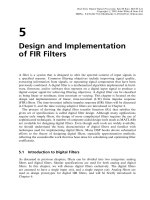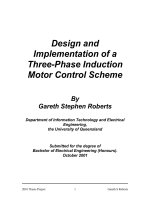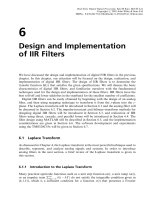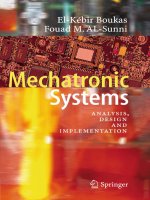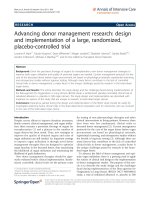Mechatronic Systems : Analysis, Design and Implementation potx
Bạn đang xem bản rút gọn của tài liệu. Xem và tải ngay bản đầy đủ của tài liệu tại đây (4.54 MB, 523 trang )
Mechatronic Systems
El-Kébir Boukas and Fouad M. AL-Sunni
Mechatronic Systems
Analysis, Design and Implementation
ABC
Authors
Prof. El-Kébir Boukas
Mechanical Engineering Department
Ecole Polytechnique de Montreal
P.O. Box 6079, Station “centre-ville"
Montreal, Quebec, H3C 3A7
Canada
Email:
Prof. Fouad M. AL-Sunni
Department of Systems Engineering
King Fahd University of Petroleum
and Minerals
Dhahran, 31261
Saudi Arabia
E-mail:
ISBN 978-3-642-22323-5 e-ISBN 978-3-642-22324-2
DOI 10.1007/978-3-642-22324-2
Library of Congress Control Number: 2011931791
c
2011 Springer-Verlag Berlin Heidelberg
This work is subject to copyright. All rights are reserved, whether the whole or part of the mate-
rial is concerned, specifically the rights of translation, reprinting, reuse of illustrations, recitation,
broadcasting, reproduction on microfilm or in any other way, and storage in data banks. Dupli-
cation of this publication or parts thereof is permitted only under the provisions of the German
Copyright Law of September 9, 1965, in its current version, and permission for use must always
be obtained from Springer. Violations are liable to prosecution under the German Copyright Law.
The use of general descriptive names, registered names, trademarks, etc. in this publication does
not imply, even in the absence of a specific statement, that such names are exempt from the relevant
protective laws and regulations and therefore free for general use.
Typeset & Cover Design: Scientific Publishing Services Pvt. Ltd., Chennai, India.
Printed on acid-free paper
987654321
springer.com
Preface
Nowadays most of the systems are computer controlled among them we quote
mechatronic systems where the intelligence is implemented in microcontrollers. The
discipline that deals with such systems is mechatronics that we define as the syner-
gistic combination of mechanical engineering, electronic engineering, and software
engineering. The purpose of this interdisciplinary engineering field is to control
complex systems by providing hardware and software solutions. The engineers
working in this field must master concepts in electronics, control and programming.
Examples of such systems can be found in different industrial areas ranging from
aerospace to automobile industries.
In the mechanical part, the engineer must follow a rigorous procedure to design
the mechatronic system. He must build the mechanical part of the system and choose
the appropriate sensors and actuators that have to be used in the functioning of
the mechatronic system. At this phase we must think about the place where the
electronic circuit will be integrated.
In the electronics part, the engineer must design the electronic circuit around mi-
crocontrollers that will assure the functioning of the mechatronics systems. It covers
the integration of the required electronics components such as resistors, capacitors,
integrated circuits, sensors and the chosen microcontrollers. The required regulated
voltage for the different components is also part of this step.
In the control part, the engineer must analyze the system under study and design
the appropriate controller to get the desired performances. In the analysis part, we
should start by establishing an acceptable model that gives the relationship between
the inputs and the outputs. Once the dynamics is mastered a sampling period is
chosen and the model is converted to a discrete-time form and an appropriate con-
troller can be chosen among the classical proportional integral and derivative (PID)
VI
controller or the state feedback controller or any other controller that can give the
desired performances.
In the programming part, the engineer must develop the code of the appropriate
algorithms and then upload it in the memory of the chosen microcontroller. Many
languages can be used for this purpose. In the rest of this volume, the C language is
used to implement the developed algorithms.
The field of mechatronics is blooming and due to its interdisciplinarity many uni-
versities around the world have introduced complete programs on mechatronics in
their curriculum. Also the number of students that are attracted by this field is also
blooming and many research directions related to this have emerged recently. Huge
efforts have been done to structure research in this discipline and we have seen re-
cently many international conferences totally dedicated to this. Also some journals
have been created to report interesting results on the subject. Unfortunately the num-
ber of book dealing with such discipline is limited and sometimes inappropriate for
some courses in the different programs around the world.
This book provides some tools that engineers working on the mechatronics disci-
pline can use. It can be considered as a reference for a second course in mechatronics
curriculum where the students are supposed to have a prerequisite course in which
the structure and the different components on mechatronics systems have been
presented. It focuses only on the analysis, design and implementation of continuous-
time systems controlled by microcontrollers using advanced algorithms to get the
desired performances.
The hardware design of the mechatronic systems represents the hearth of the
mechatronics field. It consists of designing the different parts of the mechatronic
systems. Mainly beside the electronic circuit, we should select the appropriate sen-
sors and actuators that we can use for our mechatronic system. The choice of the
microcontroller is also important for the success of the desired system.
In the modeling part a model to describe the behavior of the system is developed
either using the transfer function or the state space representation. In the transfer
function approach part, the model of the continuous-time systems is converted to
a discrete-time system and different techniques for analysis and synthesis of con-
trollers to guarantee some desired performances are developed. In the state space
approach part, the model of the continuous-time systems is converted to a discrete-
time state space representation and different techniques for analysis and synthesis
of controllers to assure some desired performances are developed.
The part on implementation will focus on how we can implement the control
algorithm we developed either using the transfer function tools or the ones based on
state space. Both the hardware and software parts will be covered to give an idea for
the reader on how to deal with such problems. Mainly the selection of the sensors
and the actuators that may be used in the mechatronic system will be covered.
In the advance control part, a flavor of how to design controllers that handle un-
certainties and external disturbances in the dynamics is presented. This will give an
idea to the reader on robust control technique and get familiar with implementation
of these techniques. Stability and stabilization problems and their robustness are
covered. Different controllers (state feedback, static output feedback and dynamic
VII
output feedback) are used and linear matrix inequality (LMI) condition is developed
to design such controllers.
In the case studies part, a certain number of practical examples are presented to
show how the concepts we presented earlier are implemented to obtain a functional
mechatronics systems. More detail is given to help the reader to design his own
mechatronic system in the future.
The rest of this book is organized in seven parts and divided in eleven chap-
ters and one appendix. In the introduction, a general overview of the mechatronics
fields is given and the main concepts are recalled to make the book self-contained.
In Chapter 2, the structure of mechatronic systems are detailed and some examples
are given. Chapter 3 which is a part of the modeling part, deals with the model-
ing problem of the class of linear continuous-time systems. Both the physical laws
and identification approaches are covered. The concepts of transfer function and
state space representations are presented. Chapter 4 treats the Z -transform and its
properties and how the transfer function is obtained from a model that is given in
a set of differential equations. Other techniques for analysis of such systems are
also covered. In Chapter 5, some design approaches based on transfer function
are developed. Chapter 6 deals with the state space approach for analyzing linear
discrete-time systems. The concepts of stability, controllability and observability
are covered. In Chapter 7, the state feedback, static output and dynamic output sta-
bilization techniques are tackled. Chapter 8 deals with the implementation problem
of the control algorithm we may develop for controlling a given continuous-time
system. The focus will be made on all the steps. Mainly the hardware and software
parts are covered in detail to help the reader to develop his own expertise. Chap-
ter 9 presents some ideas on robust control. Stability and stabilization problems for
systems with uncertainties and external disturbances are tackled. Chapter 10 covers
the guaranteed cost control problem. Different types of controllers are used for this
purpose. In Chapter 11 some selected systems are considered and all the concepts
we developed in this book are applied to give the whole picture for the reader. An
appendix that contains some relevant tools is also provided to try to make the book
self-contained.
El-K´ebir Boukas
Fouad M. AL-Sunni
´
ebir Boukas
Missing a very dear friend
Born in Morocco in 1954, Prof. Boukas obtained his BS Electrical Engineering
degree from Ecole Mohammadia des Ingenieurs with excellent standing and with
an early focus on control and application on large scale systems. Since then, he was
fascinated by the area of control and its application. To fulfil his design of knowing
more about it, he moved to Canada to pursue his higher studies. A decision which
proved rewarding, he finished his MS and PhD in Electrical Engineering from Ecole
Polytechnique of Montreal, and established himself as an authority in his area of
specialization of control and automation with specialization in the use of control
tools in manufacturing , maintenance and inventory control.
In his mid- fifties, he left us while still active in his research and very productive.
In fact, the manuscript of this book was with him while in hospital during the last
few weeks of his life. He left behind an excellent profile of accomplishments in the
form of 167 High caliper International Journals, more than 8 booksand many educa-
tional software and materials, and very visible presence in international conferences
with more than 125 papers and presentations in conferences and involvements in
organizations, and international technical committee of several of conferences over
the years.
After fighting for his life, he passed away peacefully and he left behind his loyal
wife , two daughters (A dentist, and an MD) and one son (soon to-be physical
therapist).
I have known him since 1996, and since his visit to us in King Fahd University
of Petroleum and Minerals, I have known him to be a kind, nice, helpful, and dear
friend to all. He has been one of my best friends that I will always remember. He left
me with the job of completing this manuscripts and then to translate it to Arabic to
be the first textbook on the subject. The English version is now out, and the Arabic
version is being scheduled at a later time.
Fouad M. AL-Sunni
1 Introduction 1
1.1 MechanicalPartDesign 3
1.2 ElectronicCircuitDesign 4
1.3 Real-TimeImplementation 7
1.4 OrganizationoftheBook 19
I Mechatronic Systems 21
2 Mechatronic Systems 23
2.1 Mechatronics 23
2.2 MechanicalPart 26
2.3 Sensors 27
2.4 Actuators 29
2.5 ElectronicCircuit 30
2.6 Real-TimeImplementation 31
2.7 ExamplesofMechatronicSystems 34
2.7.1 DcMotorControl 34
2.7.2 Two Wheels Robot 37
2.7.3 MagneticLevitation 40
2.8 Conclusions 40
2.9 Problems 40
XII Contents
II Modeling 43
3 Mathematical Modeling 47
3.1 MathematicalModelingBasedonPhysicsLaws 48
3.1.1 ConceptofTransferFunction 49
3.1.2 StateSpaceDescription 50
3.2 Identification 60
3.2.1 TransferFunctionApproach 60
3.2.2 StateSpaceDescriptionApproach 63
3.3 Conclusions 66
3.4 Problems 66
III Transfer Function Approaches 69
4 Analysis Based on Transfer Function 73
4.1 Introduction . . . 73
4.2 SamplingProcess 75
4.3 TransferFunctionConcept 94
4.4 Time Response and Its Computation. . 104
4.5 Stability and Steady-State Error 108
4.6 RootLocusTechnique 115
4.7 BodePlotTechnique 119
4.8 Conclusions 124
4.9 Problems 124
5 Design Based on Transfer Function 129
5.1 Introduction . . . 129
5.2 FormulationoftheControlDesignProblem 130
5.3 Design Based on Empirical Methods . 132
5.4 DesignBasedonRootLocus 141
5.5 DesignBasedonBodePlot 167
5.6 CaseStudy 190
5.6.1 Proportional Controller . 190
5.6.2 Proportional and Integral Controller 192
5.6.3 Proportional and Derivative Controller . . . 194
5.6.4 Proportional Integral and Derivative Controller . 196
5.6.5 PhaseLeadController 198
5.6.6 PhaseLagController 202
5.6.7 PhaseLead-LagController 206
5.7 Conclusion 211
5.8 Problems 212
Contents XIII
IV State Space Approaches 215
6 Analysis Based on State Space 217
6.1 Introduction . . . 217
6.2 StateSpaceConcept 218
6.3 Time Response and Its Computation. . 239
6.4 Stability . 242
6.5 Controllability and Observability 248
6.6 CaseStudy 277
6.7 Conclusion 278
6.8 Problems 278
7 Design Based on State Space 283
7.1 Introduction . . . 283
7.2 FormulationoftheControlDesignProblem 284
7.3 StateFeedbackControllerDesign 285
7.4 OutputFeedbackControllerDesign 304
7.5 LinearQuadraticRegulator 324
7.6 CaseStudy 333
7.7 Conclusions 336
7.8 Problems 336
V Implementation 341
8 Design and Implementation of Mechatronic System 343
8.1 Introduction . . . 343
8.2 DesignPhase 344
8.3 ElectronicDesign 348
8.4 SoftwareDesignandReal-TimeImplementation 348
8.4.1 dsPIC30F4011 . . . 348
8.4.2 Pusle Width Modulation 353
8.4.3 Interrupts 361
8.5 DesignandImplementationBasedofTransferFunction 365
8.6 DesignandImplementationBasedonStateSpace 371
8.7 Conclusions 376
8.8 Problems 377
VI Advanced Control 379
9 Robust Control 383
9.1 Stability Problem 385
9.2 Stabilization 392
9.3 H
∞
Stabilization 412
XIV Contents
9.3.1 State-FeedbackControl 416
9.3.2 Static Output Feedback H
∞
Control 420
9.3.3 Output-FeedbackControl 422
9.4 Conclusion 425
9.5 Problems 426
10 Guaranteed Cost Control Problem 431
10.1 Introduction . . . 431
10.2 ProblemStatement 432
10.3 StateFeedbackControlDesign 433
10.4 OutputFeedbackControl 438
10.5 Conclusion 444
10.6 Problems 444
VII Case Studies 447
11 Case Studies 449
11.1 Introduction . . . 449
11.2 VelocityControlofthedcMotorKit 450
11.3 Position Control of the dc Motor Kit . 457
11.4 Balancing Robot Control . 467
11.5 MagneticLevitationSystem 474
11.6 Conclusion 484
11.7 Problems 484
A C Language Tutorial 487
References 495
Index 497
List of Figures
1.1 Loaddrivenbyadcmotorkit 5
1.2 Electroniccircuitofthedcmotorkit 6
1.3 Signalconversionmadeintheforwardpath 6
1.4 Signalconversionmadeinthefeedbackpath 6
1.5 Partition of the sampling period T 13
1.6 Trafficsystem 14
1.7 Type of light used in the trafficlightsystem 15
2.1 Mechatronicdesignapproach 24
2.2 Real-timeimplementationsetup 36
2.3 Electroniccircuitofthedcmotorkit 37
2.4 Balancing robot . 38
2.5 Electronic circuit of the balancing robot 39
2.6 Magneticlevitatiossystem 41
2.7 Block diagram of continuous-time system . . . 46
2.8 Block diagram of continuous-time linear system. . . 46
3.1 Blockdiagramofadcmotor 49
3.2 Tilt dynamics free body diagram . 53
3.3 Wheels and linear displacement free body diagram 53
3.4 Heading dynamics free body diagram. . 56
4.1 Signalconversionismadeintheforwardpath 74
4.2 Signalconversionismadeinthefeedbackpath 74
4.3 Samplingprocess 77
XVI List of Figures
4.4 Samplingperiodchoice 78
4.5 Transformationofthes-planeintoz-plane 88
4.6 Transformationofthes-planewhentherealpartisconstant 88
4.7 Forwardintegration 90
4.8 Backwardintegration 91
4.9 Trapezoidalintegration 91
4.10 Pulse transfer function definition. 95
4.11 Cascadetransferfunctionswithsamplerbetween 96
4.12 Cascade transfer functions without sampler between 97
4.13 Transferfunctionsinfeedback 98
4.14 Transferfunctionsinfeedback 99
4.15 Transferfunctionsinfeedback 100
4.16 Transferfunctionsinfeedback 101
4.17 Transferfunctionsinfeedback 101
4.18 Transferfunctionsinfeedback 102
4.19 Transferfunctionsinfeedback 102
4.20 Transferfunctionsinfeedback 102
4.21 Behavior of the time response for a step input 105
4.22 Blockdiagram(BD) 106
4.23 Blockdiagramoftheclosed-loop 109
4.24 BD of the system with characteristic eqn: 1 + K
(z+1)
(z−1)
2
= 0 118
4.25 RL of the system with characteristic eqn: 1 + K
(z+1)
(z−1)
2
= 0 118
4.26 BD of the system with characteristic eqn: 1 + K
z
(z−1)(z−0.368)
= 0 119
4.27 RL of the system with characteristic eqn: 1 + K
z
(z−1)(z−0.368)
= 0 120
4.28 Speedcontrolofmechanicalpartdrivenbyadcmotor 123
4.29 Bode diagram of
1.9989
(
1−0.05w
)
1+w
125
4.30 Transferfunctionsinfeedback 126
4.31 Blockdiagramoftheclosed-loop 127
5.1 Blockdiagramoftheclosed-loop 131
5.2 Ziegler-Nichols methods: stable case . . 133
5.3 Step response of a stable dynamical system . . 134
5.4 Step response of the closed-loop dynamics with a PID controller . . . 135
5.5 Ziegler-Nichols: unstable case (a) and determination of T
c
(b) 136
5.6 Step response of the closed-loop dynamics with a PID controller . . . 138
5.7 Step response of the closed-loop dynamics with a PID controller . . . 140
5.8 Root locus of
1
s(s+1)
142
5.9 Step response of
0.5
s(s+1)+0.5
143
5.10 Root locus of
s+z
s(s+1)
, z = −3.6 146
5.11 Step response of
5K
P
s+5K
I
s
2
+(1+5K
P
)s+5K
I
147
5.12 Root locus of
s+z
s(s+1)
, z = 6.7273 . . 150
5.13 Step response of
s+z
s(s+1)
, z = 6.7273 151
5.14 Root locus of
s+a
2
s(s+3)
, a
2
= 6 153
5.15 Step response of
s+a
2
s(s+3)
, a
2
= 6 154
List of Figures XVII
5.16 Root locus of
s+
1
aT
s(s+2)(s+
1
T
)
156
5.17 Step response of F(s) =
2aK
P
(
s+
1
aT
)
s
3
+
(
2+
1
T
)
s
2
+
(
2
T
+2aK
P
)
s+
2K
P
T
157
5.18 Root locus of
1
s(s+2)
159
5.19 Root locus of
s+0.3
s(s+2)(s+0.06)
161
5.20 Step response of F(s) =
2aK
P
(
s+
1
aT
)
s
3
+
(
2+
1
T
)
s
2
+
(
2
T
+2aK
P
)
s+
2K
P
T
162
5.21 Step response of F(s) =
2aK
P
(
s+
1
aT
)
s
3
+
(
2+
1
T
)
s
2
+
(
2
T
+2aK
P
)
s+
2K
P
T
163
5.22 Root locus of
s+
1
a
1
T
1
s(s+2)
s+
1
T
1
165
5.23 Root locus of
s+
1
a
1
T
1
s+
1
a
2
T
2
s(s+2)
s+
1
T
1
s+
1
T
2
166
5.24 Step response of F(s) 167
5.25 Bode plot of T(s), with K = 1, and K = kK
P
169
5.26 Step response of F(s) 171
5.27 Bode plot of T(s), with K = 1 173
5.28 Step response of F(s) 174
5.29 Bode plot of T(s), with K = 10 176
5.30 Step response of F(s) 177
5.31 Bode plot of T(s) 179
5.32 Step response of F(s) 180
5.33 Bode plot of T(s) 183
5.34 Step response of F(s) 184
5.35 Bode plot of T(s) 186
5.36 Step response of F(s) 187
5.37 Bode plot of T(s) 188
5.38 Bode plot of T(s)
K
s(τ
m
s+1)
, with K = 1, and K = K
m
K
P
191
5.39 Root locus of T(s) =
1
s(τ
m
s+1)
192
5.40 Step response of F(s) =
K
m
K
P
τ
m
s
2
+s+K
m
K
P
193
5.41 Bode plot of T(s)
K(0.5s+1)
s
2
(τ
m
s+1)
, with K = 1, and K = K
m
K
P
194
5.42 Root locus of T(s) =
0.25s+1
s
2
(τ
m
s+1)
195
5.43 Step of F(s) with two controllers for two design methods 196
5.44 Bode plot of T(s)(compensatedandnoncompensatedsystem 197
5.45 Step of F(s) with two controllers for two design methods 198
5.46 Root locus of T(s) =
(
1
13
s+1)(
1
15
s+1)
s
2
(τ
m
s+1)
, 199
5.47 Bode plot of T(s) =
100(
1
12
s+1)(
1
15
s+1)
s
2
(τ
m
s+1)
200
5.48 Step response of F(s)withthetwocontrollers 201
5.49 Root locus of T(s) =
aT s+1
s(τ
m
s+1)(Ts+1)
202
5.50 Bode plot of T(s)
100
s(τ
m
s+1)
203
XVIII List of Figures
5.51 Step of F(s) with two controllers for two design methods 204
5.52 Bode plot of T(s)
100
(τ
m
s+1)
205
5.53 Step of F(s) with two controllers for two design methods 206
5.54 Root locus of T(s)
K(0.5s+1)
s
2
(τ
m
s+1)
, with K = 1, and K = K
m
K
P
208
5.55 Bode plot of T(s)
K(0.5s+1)
s
2
(τ
m
s+1)
, with K = 1, and K = K
m
K
P
209
5.56 Step of F(s) with two controllers for two design methods 210
6.1 Blockdiagramofdiscrete-timelinearsystem 220
7.1 Blockdiagramofdiscrete-timelinearsystem 286
7.2 Behavior of the output versus time with state feedback controller. . . 291
7.3 Behaviorofstatesvstimewithstatefeedbackcontroller 298
7.4 Blockdiagramofdiscrete-timelinearsystem 306
7.5 Behavioroftheoutputvstimewithstatefdkcontroller 316
7.6 Behavioroftheoutputvstimewithstatefdkcontroller 321
7.7 Behaviorofthecontrollergainsversusiteration 329
7.8 Behavioroftheoutputvstimewithstatefdkcontroller 330
7.9 Behavioroftheoutputvstimewithstatefdkcontroller 333
7.10 Behaviorofthestatesvstimewithstatefdkcontroller 334
7.11 Behaviorofthestatesvstimewithstatefdkcontroller 335
7.12 Behaviorofthestatesvstimewithstatefdkcontroller 336
8.1 Two wheels robot 347
8.2 dsPIC30F4011 pins description . . 350
8.3 ExampleofPWMsignal 353
8.4 Blockdiagramoftheclosed-loop 365
8.5 Root locus of the dc motor with a proportional controller 369
8.6 Output of the load driven by a dc motor vs time with ’p’ controller . 369
8.7 Time response for a step function with 1 as amplitude . . . 371
8.8 Time response for a step function with 1 as amplitude . . . 373
8.9 Behavior of the output for a non null initial conditions. . . 374
8.10 Behaviorofthesystem’sstates 375
8.11 Behavioroftheobserver’sstates 376
11.1 Electroniccircuitofdcmotorkit 451
11.2 Real-timeimplementationsetup 452
11.3 Root locus of the dc motor with a proportional controller 459
11.4 Time response for a step function with 30 degrees as amplitude . . . 460
11.5 Time response for a step function with 30 degrees as amplitude . . . 462
11.6 Time response for a step function with 30 degrees as amplitude . . . 464
11.7 Outputversustime 466
11.8 System’sstatesversustime 467
11.9 Observer’sstatesversustime 468
11.10 Balancing robot 469
11.11 Electronic circuit of the balancing robot 470
List of Figures XIX
11.12 Outputsversustime 471
11.13 Statesversustime 472
11.14 Magneticlevitatiossystem 476
11.15 Time response for moving object 478
List of Tables
3.1 Variables definition . . . 52
3.2 Variables definition . . . 55
3.3 Dataofthemagneticlevitationsystem 57
4.1 Z-transformtable 81
4.2 Poles in the z-plane using z = e
j
2πω
ω
s
87
5.1 Ziegler-Nichols methods: controller parameters . . . 133
5.2 Ziegler-Nichols method: case of unstable systems . 136
5.3 ZieglerNicholsmethodinfrequencydomain 139
5.4 ComparativestudyofthedesignofPcontroller 192
5.5 Difference equations for the differentcontrollers:dcmotorkit 211
8.1 Conventionfordcmotormovement 363
11.1 Dataofthemagneticlevitationsystem 477
A.1 List of C language keywords 489
A.2 Numberrepresentations 489
A.3 Integerrepresentations 489
A.4 Decimalrepresentations 490
A.5 Arithmeticoperations 491
A.6 Logicoperations 491
A.7 Logicoperations 492
A.8 Logicoperations 493
Introduction
After reading this chapter the reader will:
1. have an idea on how we design mechatronic systems
2. know what are the phases of the design of such systems
3. have a clear idea on how to deal with each phase of the design of the
mechatronic systems
The progress and the miniaturization we have seen in electronics during the last
decades have allowed engineers to come up with new products and new engineering
disciplines. Early in the eighteens we have seen the introduction of new products
that combines mechanical parts with electronics parts. Another factor that gives
a booming to mechatronics applications is the continuously decreasing prices of
the electronic parts and the challenges to design very small systems. Today, for
instance microprocessors with high performances are becoming very cheap which
encourages their uses in computer controlled systems.
A microprocessor is an integrated circuit that contains the entire central process-
ing unit of a computer on a single chip. The microprocessor is the main part in our
nowadays computers. It does all the necessary computations and treats the data. The
microprocessors have the following components:
2 1. Introduction
• control unit
• arithmetic and logic unit
• input/output (I/O) data bus
• address bus
• internal registers
• clock
• etc.
To construct the computers, other peripherals and components are added to the
main part which is the microprocessor. Screens, hard disk, floppies, memory, etc.
are examples of such peripherals that we can have in our computers. For the com-
puter controlled systems, we need appropriate cards known as data acquisition cards.
These devices come with analog to digital (ADC) and digital to analog (DAC) con-
verters and other necessary components real-time control applications. For some
mechatronic systems, the use of computers and data acquisition cards are not appro-
priate and more often we use instead electronic circuit built around microcontrollers
that can be considered as small microprocessor with their own peripherals.
A microcontroller is an integrated circuit as it is the case of the microprocessor
and consisting of:
• a relatively simple central processing unit (CPU)
• memory
• a crystal oscillator
• timers,
• watchdog,
• serial and analog I/O
• pulse-width modulation (PWM) modules
• etc.
Microcontrollers are designed for small applications, while the microprocessors
are used in high performance applications and personal computers. The Intel mi-
croprocessors that run in our laptops are examples of these microprocessors and
the PICs of Microchip
1
are examples of microcontrollers. These machines are used
in almost all the products that we use in our daily life. As examples that use
microcontrollers, we quote:
• cars
• airplanes
1
Microchip is a trademark, see www.microchip.com
1.1. Mechanical Part Design 3
• cellular phones
• digital cameras
• etc.
Nowadays most of the systems are computer controlled where the intelligence of
these mechatronic systems is implemented in microcontrollers. The discipline that
deals with such systems is mechatronics that we define as the synergistic combina-
tion of mechanical engineering, electronic engineering, and software engineering.
The purpose of this interdisciplinary engineering field is to build and control com-
plex systems by providing hardware and software solutions. The engineers working
in this field must master concepts in electronics, control and programming. Ex-
amples of such systems can be found in industrial areas ranging from aerospace
industry to car industry.
The design of mechatronic systems is a task that requires engineers from different
disciplines like mechanical engineering, electrical engineering, control engineering,
computer engineering, etc. The knowledge of these engineers are combined to pro-
duce the best mechatronic system. Most of these mechatronic systems are composed
of:
• a mechanical part including the actuators and sensrors
• an electronic circuit that is built around a microcontroller or a set of
microcontrollers
• a real-time implementation that represents the intelligence of the system
As example of mechatronic system, let us consider a laboratory setup for
real-time implementation of control algorithms. This setup must have all the
functionalities that allow learning real-time control. More specifically,
• the mechanical part must allow the user to check the output of the control
algorithm
• an electronic circuit must be simple and easy to reproduce by the user in case
• the implementation must be easy to do and well documented.
In the rest of this chapter we will describe briefly each phase of the design of the
whole mechatronic systems.
1.1 Mechanical Part Design
The mechanical part is a principle part in the mechatronic system. In the phase
design of this part, we will conceive and manufacture the parts that compose the
mechatronic system. We will also choose the actuators and the sensors we will use
for this mechatronic system. Either the design of the mechanical part or the choice of
the actuators and sensors are done by respecting some design rules that will be pre-
sented in a forthcoming chapter of the volume. It is also important to keep in mind
